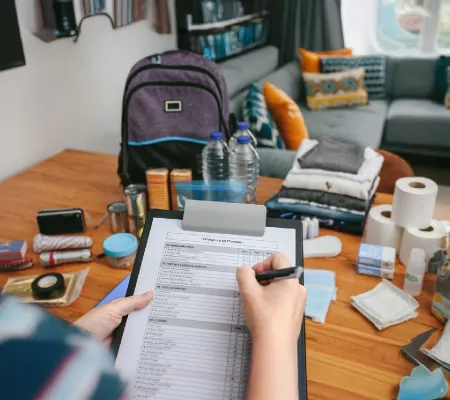How Can I Prepare for Hurricane Season in North Carolina?

June brings the start of summer—and the start of Atlantic hurricane season. Are you ready to weather the next big storm?
You may think you have plenty of time before hurricane season peaks in August and September. But the best time to prepare is before the first storm forms. Planning now means you can get ready without the stress of an incoming storm, before local stores have long lines and empty shelves.

Trillium’s Roadmap2Ready campaign provides valuable information before, during, and after stores that impact our region.
The hardest part is starting. This blog will help you get started. There are three main tasks: Make a plan, build your emergency kit, and stay informed.
Make a Plan
 Having a plan can help your family feel calm and safe during a stressful time. To make your plan, discuss your answers to these questions.
Having a plan can help your family feel calm and safe during a stressful time. To make your plan, discuss your answers to these questions.
- How will you receive emergency alerts, warnings, and other important information?
- What will your family need if the power goes out?
- Are you in a coastal evacuation zone? If you must evacuate, where will your family go?
- What important papers or documents do you need to take if your family evacuates? Examples include your insurance policies, deeds, ID cards, and birth certificates.
- If you or a family member have a mental health condition or disability, what supplies will help you/them stay calm and feel safe?
Including children in your family’s preparations doesn’t have to be scary. In fact, it can make hurricane season less scary for them by helping them feel more in control. Find appropriate ways to involve them in your family’s planning.
Build Your Emergency Kit
 You probably have most of the supplies you need to build your emergency kit. You just need to pack them in a container that’s easy to carry or transport. A backpack, duffel bag, or storage tote are all options. If you need to buy some items, it’s best to start looking for them now. It can be hard to find items you need in the days before a hurricane because many people wait to buy supplies until this time.
You probably have most of the supplies you need to build your emergency kit. You just need to pack them in a container that’s easy to carry or transport. A backpack, duffel bag, or storage tote are all options. If you need to buy some items, it’s best to start looking for them now. It can be hard to find items you need in the days before a hurricane because many people wait to buy supplies until this time.
In general, your kit should include everything your household needs for at least three days.
- Water: Include one gallon of water per person per day. For example, a household with three people needs at least nine gallons of water. You can buy gallons of water, or you can wash and save milk gallon jugs to fill with water in the days leading up to a storm.
- Food: Pack items you can easily eat if your power is out, like canned foods, nuts or nut butters, protein or fruit bars, cereal, juice, and comfort foods.
- Weather radio or battery-powered radio: Make sure you can still receive information if your cell service or power is out.
- Flashlights: Candles can be a fire risk. Battery-powered flashlights are a safer choice.
- Medical needs: Include prescriptions and medications, first aid supplies, and personal hygiene items.
- Entertainment and comfort: Pack things to help your family pass the time like books and games.
- Pet care: Don’t forget food, water, and other items your pet will need for at least three days.
Encourage each family member to pack what they will need. This helps everyone feel a sense of comfort and control.
Stay informed
 Hurricanes can happen in unpredictable ways. Forecasts for developing storms often change from day to day. It’s important to have access to accurate information before, during, and after a storm.
Hurricanes can happen in unpredictable ways. Forecasts for developing storms often change from day to day. It’s important to have access to accurate information before, during, and after a storm.
Here are some things you can do now to make sure you have all the information you need when you need it:
- Make sure you are receiving Wireless Emergency Alerts on your cell phone.
- Follow trustworthy sources on social media, like local news outlets and your local National Weather Service station. The ReadyNC website includes links for reliable updates on road conditions, power outages, and more.
- Keep a NOAA weather radio or battery-powered radio (with back-up batteries) in your emergency kit.